
The Aachen Altar (de: Aachener Altar) or Passion Altar (Passionsaltar) is a late gothic passion triptych in the Aachen Cathedral Treasury, made by the so-called Master of the Aachen Altar around 1515/20 in Cologne. [1]

The Aachen Altar (de: Aachener Altar) or Passion Altar (Passionsaltar) is a late gothic passion triptych in the Aachen Cathedral Treasury, made by the so-called Master of the Aachen Altar around 1515/20 in Cologne. [1]
The open, three winged polyptych altar image shows scenes from the Passion of Christ to his Ascension in continuous sequence from left to right. At the assumed time of composition, this type of depiction was already well-established. On the left wing of the altar, Jesus is crowned with the Crown of thorns and confronts Pontius Pilate. The central panel depicts the Stations of the Cross, with the Crucifixion of Jesus as the central scene. This panel also shows the Harrowing of Hell and the suicide of Judas. On the right wing is the Lamentation of Christ, his burial, the meeting with Mary Magdalen, and the Ascension.
The painter stresses the passion scenes as a bloody ordeal through the use of red paint throughout the whole image. With the exception of Jesus, Mary and John, everyone is depicted in contemporary clothing in a local landscape. The biblical scenes are presented to the viewer, providing the opportunity for introspection. Furthermore, in the division of the centrepiece into a "good side" on the left of the crucifixion and a "bad side" on the right and in the direction of glances and gestures towards the viewer, the panel demands that the viewer make a personal choice between salvation and damnation.
On the left wing, the soldier bringing Jesus to Pilate has a scimitar and suit of armour of Turkish style, reflecting the great fear of a Turkish attack on Christian Europe at the time of the work's composition. In addition, a child with signs of down syndrome being deloused by a monkey in the possession of Satan, alludes to the role of Satan (who appears in person on the upper right of the central panel) in Christ's death. The thin youth with a dark beret is often considered a self-portrait of the painter. In the background of the left panel a church with unfinished towers is visible, which was long thought to be Cologne Cathedral (probably incorrectly). The Schildergasse and the Dreikönigenpförtchen have been similarly identified in the alley in front of the cathedral, while the church facade poking out from behind a column has been identified as the Carmelite cloister of Cologne.
On the outsides of the wings there are six saints under an arcade in front of a brocade pattern, who are face the viewer when the triptych is closed. The outer two saints are Carmelites and are especially emphasised by church steeples. The saints on the left wing are the Carmelite Saint Anthony of Hungary, Saint Barbara, Saint Sebastian; the saints on the left wing are Saint Lawrence, Saint Catherine and the Carmelite Saint Angel.
The exact date of the triptych's donation is not known. The supposed donor, Theodericus de Gouda was the Provincial superior of the Carmelite Cloister of Cologne and died in 1539. [2] The triptych was on the Volksaltar of the Cologne Carmelite Church until 1642. It came into the Cologne collection of the Jacob Lyversberg before 1834 after which it went to the Cologne collection of Haan, from whom Aachen Cathedral acquired it in 1872. At that point it was installed in the Choir.
The unknown master responsible for the work, tentatively identified with the engraver P.W., seems to have been active in Cologne between 1480 and 1580. This explains the close relationship of his work to the works of his contemporaries in Cologne, the Master of St Severin and the earlier Master of the legend of St. Ursula, as a demonstration of the popularity of altar images in Cologne around 1495/1500. Aspects of technique support its origin in the Middle Rhine, but Early Netherlandish influence is visible, as well as that of Antwerp Mannerism. The depiction of the sick child, the blind Roman legionnaires and the syphilitic judges betrays a degree of detail which seems almost medical. [3]

Aachen Cathedral is a Catholic church in Aachen, Germany and the seat of the Diocese of Aachen.

Pietro Lorenzetti or Pietro Laurati was an Italian painter, active between c. 1306 and 1345. Together with his younger brother Ambrogio, he introduced naturalism into Sienese art. In their artistry and experiments with three-dimensional and spatial arrangements, the brothers foreshadowed the art of the Renaissance.

Hugo van der Goes was one of the most significant and original Flemish painters of the late 15th century. Van der Goes was an important painter of altarpieces as well as portraits. He introduced important innovations in painting through his monumental style, use of a specific colour range and individualistic manner of portraiture. From 1483 onwards, the presence of his masterpiece, the Portinari Triptych, in Florence played a role in the development of realism and the use of colour in Italian Renaissance art.
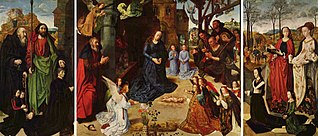
The Portinari Altarpiece or Portinari Triptych is an oil-on-wood triptych painting by the Flemish painter Hugo van der Goes, commissioned by Tommaso Portinari, representing the Adoration of the Shepherds. It measures 253 x 304 cm, and is now in the Galleria degli Uffizi in Florence, Italy. This altarpiece is filled with figures and religious symbols. Of all the late-fifteenth-century Flemish artworks, this painting is said to be the most studied.
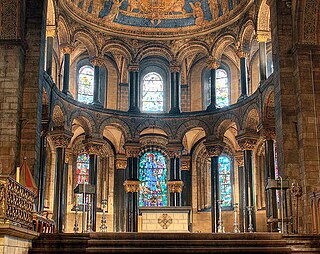
Mosan art is a regional style of art from the valley of the Meuse in present-day Belgium, the Netherlands, and Germany. Although in a broader sense the term applies to art from this region from all periods, it generally refers to Romanesque art, with Mosan Romanesque architecture, stone carving, metalwork, enamelling and manuscript illumination reaching a high level of development during the 11th, 12th and 13th centuries.
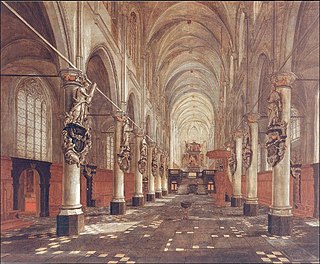
The Elevation of the Cross is the name of two paintings, a very large triptych in oil on panel and a much smaller oil on paper painting. Both pieces were painted by the Flemish artist Peter Paul Rubens in Antwerp, Belgium, the original in 1610 and the latter in 1638. The original is a winged altarpiece, with the outside of the hinged wings also painted. These can be folded over the central panel, giving an 'open view' and a 'closed view'.

The Descent from the Cross is the central panel of a triptych painting by the Baroque artist Peter Paul Rubens in 1612–1614. It is still in its original place, the Cathedral of Our Lady, Antwerp, Belgium. The painting is considered to be one of Rubens' masterpieces. The painting depicts the moment when the body of Jesus Christ is taken down from the cross after his crucifixion. The subject was one Rubens returned to again and again in his career. The artwork was commissioned on September 7, 1611, by the Confraternity of the Arquebusiers, whose patron saint was St. Christopher.

The Werl Triptych is a triptych altarpiece completed in Cologne in 1438, of which the center panel has been lost. The two remaining wings are now in the Prado in Madrid. It was long attributed to the Master of Flémalle, now generally believed to have been Robert Campin, although this identity is not universally accepted. Some art historians believe it may have been painted as a pastiche by either the workshop or a follower of Campin or the Master of Flémalle.

The Barbarossa Chandelier was made on the order of Emperor Frederick I, nicknamed Barbarossa, and his wife Beatrice sometime between 1165 and 1170 and was installed under the cupola of the Palatine Chapel in Aachen Cathedral. The chandelier was a donation in honour of Mary, Mother of God, the patroness of Aachen Cathedral and simultaneously represented a tribute to the builder of the cathedral, Charlemagne.

The Throne of Charlemagne is a throne erected in the 790s by Charlemagne, as one of the fittings of his palatine chapel in Aachen and placed in the Octagon of the church. Until 1531, it served as the coronation throne of the King of the Romans, being used at a total of thirty-one coronations. As a result, especially in the eleventh century, it was referred to as the totius regni archisolium. Charlemagne himself was not crowned on this throne, but instead in the Old St. Peter's Basilica in Rome by Pope Leo III in 800 AD.

The Liuthar Gospels are a work of Ottonian illumination which are counted among the masterpieces of the period known as the Ottonian Renaissance. The manuscript, named after a monk called Liuthar, was probably created around the year 1000 at the order of Otto III at the Abbey of Reichenau and lends its name to the Liuthar Group of Reichenau illuminated manuscripts. The backgrounds of all the images are illuminated in gold leaf, a seminal innovation in western illumination.

The notname Master of the Aachen Altar is given to an anonymous late gothic painter active in Cologne between 1495 and 1520 or 1480 and 1520, named for his master work, the Aachen Altar triptych owned by the Aachen Cathedral Treasury. Along with the Master of St Severin and the Master of the legend of St. Ursula he is part of a group of painters who were active in Cologne at the beginning of the sixteenth century and were Cologne's last significant practitioners of late gothic painting.

The Master of Delft was a Dutch painter of the final period of Early Netherlandish painting, whose name is unknown. He may have been born around 1470. The notname was first used in 1913 by Max Jakob Friedländer, in describing the wings of a Triptych with the Virgin and Child with St Anne with the central panel by the Master of Frankfurt, which is now in Aachen. This has donor portraits of an identifiable family from Delft, that of the Burgomaster of Delft, Dirck Dircksz van Beest Heemskerck (1463–1545), with his wife and children.

The Saint Columba Altarpiece is a large c. 1450–1455 oil-on-oak wood panel altarpiece by Early Netherlandish painter Rogier van der Weyden painted during his late period. It was commissioned for the church of St. Columba in Cologne, and is now in the Alte Pinakothek, Munich.
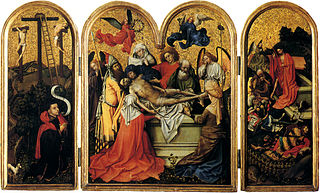
The Seilern Triptych, variously dated c. 1410-15 or c. 1420–25, is a large oil and gold leaf on panel, fixed winged triptych altarpiece generally attributed to the Early Netherlandish painter Robert Campin. It is the earliest of two known triptychs attributed to him, although the outer wing panels paintings are lost. The work details the events of Christ's passion; with iconography associated with the liturgy of Holy Week. The panels, which should be read from left to right, detail three stations of the cycle of the Passion of Jesus; the crucifixion, the burial and the resurrection.

The Bladelin Altarpiece, or Middelburg Altarpiece, is a triptych painting created around 1450 by the Flemish painter Rogier van der Weyden, towards the end of his artistic career. It depicts scenes relating to the birth of Jesus; and as the only nativity scene definitively attributed to van der Weyden is sometimes known as the Nativity Triptych.

The Adoration of the Magi Altarpiece is a painted triptych by the German artist Stefan Lochner, created c. 1440–1442. Originally painted for the council-chapel St. Maria in Jerusalem in Cologne, it was moved to Cologne Cathedral in 1810 and is now in that church's Marienkapelle, south of the choir. It is also known as the Three Kings Altarpiece (Dreikönigsaltar) and the Patron Saints of Cologne Altarpiece.
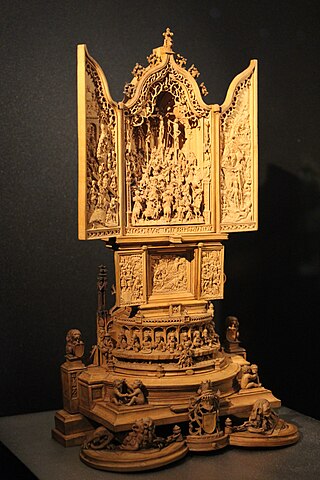
The miniature altarpiece in the British Museum, London, is a very small portable Gothic boxwood miniature sculpture completed in 1511 by the Northern Netherlands master sometimes identified as Adam Dircksz, and members of his workshop. At 25.1 cm (9.9 in) high, it is built from a series of architectural layers or registers, which culminate at an upper triptych, whose center panel contains a minutely detailed and intricate Crucifixion scene filled with multitudes of figures in relief. Its outer wings show Christ Carrying the Cross on the left, and the Resurrection on the right.

The Herrenberg Altarpiece is a winged altarpiece, that was created between 1518 and 1521 for the Brethren of the Common Life, a German Roman Catholic pietist community. It was built as a high altar for the collegiate church in Herrenberg in the state of Württemberg, now part of southwest Germany. Today the altarpiece, which has only survived in part, is in the possession of the Stuttgart State Gallery.
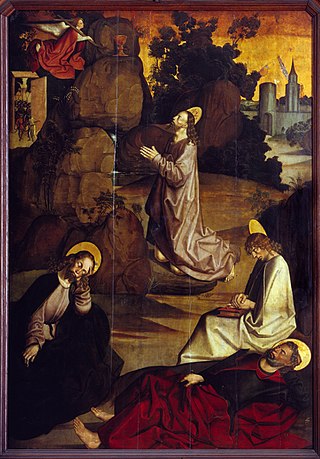
The Litoměřice Altarpiece (1505–1507) was a large altar retable, in all likelihood with two pairs of movable wings and two pairs of fixed ones. From these wings, six panels have survived, two of which are painted on both sides. The movable wings on the left-hand side of the altar are presumed lost. The altar wing depicting Christ on the Mount of Olives belongs to the Diocese of Litoměřice, while the other panels are owned by the Regional Museum in Litoměřice. It is the largest surviving set of panel paintings by an anonymous late Gothic and early Renaissance painter called the Master of the Litoměřice Altarpiece. The altarpiece is part of the permanent collection of the North Bohemian Gallery of Fine Art in Litoměřice.